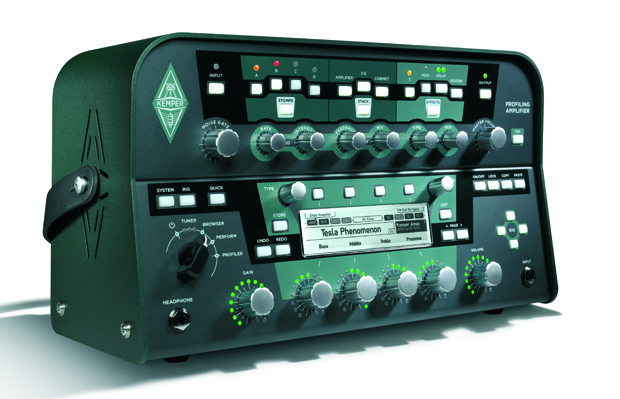Review: Kemper Profiling Guitar Amp — Video

Today’s digital modeling technology delivers many very impressive sounds, but sometimes playing through even the best guitar amp models feel like you’re wearing someone else’s clothes.
If you own some of the same amps commonly found in modeling software and products, you know what I’m talking about. While many models sound great, they may not sound quite as good as that vintage Marshall “Plexi” you sought for more than a decade until the right one came along, or that magical tweed Fender you own that has its own personality.
The Kemper Profiling Amp revolutionizes the digital modeling by enabling users to create their own models of any amp and swap and share thousands of models with a vibrant online community of Kemper owners.
By taking a digital snapshot of amp or even amp emulation software tones, the Kemper Profiling Amp allows you to take your studio sounds to the stage or bring your entire amp collection on the road without the excess bulk, weight and maintenance hassles. It’s also a great tool for the studio that enables users to save any guitar tone and replicate it in case it’s needed several months later to fix or re-do a track.
FEATURES
The Kemper Profiling Amp provides a complete rig. The signal chain consists of, in order, stomp effects, the amp stack with equalizer section and speaker cabinets, and stereo master effects. The stomp section offers up to four effects at once, selected from eight effect types: distortion, wah, chorus, phaser/flanger, compressor, EQ, delay and effect loop. The stack section consists of the amplifier module, EQ and cabinet. The studio effect section has four selections: X, consisting of the stomp effects in stereo; Mod, which is the same as the stomp modulation effects, but with two parameters controllable via the front-panel knobs; and delay and reverb. Like an amp, the front panel has gain, volume and master volume controls as well as multifunction knobs below the large LCD, which are generally used to adjust bass, middle and treble tone settings.
The rear panel offers a wide variety of connection options. A standard 1/4-inch guitar input and 1/4-inch headphone jack are conveniently located on the front panel, while various outputs, digital S/PDIF In and Out, MIDI In/Out/Thru, two pedal/switch jacks, Ethernet network, USB and return/alternative input jacks are located out of the way on the back. Outputs include direct/send with its own ground/lift switch, monitor output also with ground/lift, left and right XLR and left and right 1/4-inch master outputs with ground/lift switch.
The Kemper Profiling Amp ships with well over 200 presets featuring amp/speaker models and effects settings already loaded and can store several hundred more presets that users create themselves or download from the Rig Exchange on Kemper’s website, which currently offers more than 3,000 rigs shared by Kemper users.
PERFORMANCE
In a nutshell, the Kemper Profiling Amp does for guitarists what sampling technology did for keyboardists. While Kemper’s pre-existing collection of models is very impressive, having the ability to profile any amp you own or can rent, borrow, steal or otherwise acquire is a true breakthrough. Performing this task is surprisingly easy, involving a simple setup where a guitar is plugged into the Kemper’s input, a cable is connected from the direct out/send jack to the amp’s input, and a microphone is positioned in front of the speaker and plugged into the return input.
The incoming mic signal is monitored either via the headphone jack or by using the main outs connected to a mixer and studio monitors. Creating an amp profile is a simple matter of selecting either the distortion or clean setting (depending on the amp’s tone) and then engaging the profile process, which sends three series of test tones that are analyzed and captured.
Basically, the Kemper takes a snapshot of a particular amp setting, and the sound it delivers is uncannily indistinguishable from a recording of it—including preamp and speaker distortion and even the mic’s individual character. If your amp produces several sounds that you like, you’ll need to create an individual profile of each setting. You can even process the sounds of rotary speaker cabinets and many non-time based effects like distortion, although some effects don’t work well with the profiling process. Further gain and EQ adjustments can be made inside the Kemper, which is particularly helpful if you love the distortion character of a tiny low-watt combo with just a volume and tone control and wish you could sculpt its tone with three-band EQ.
LIST PRICE $2,025
MANUFACTURER Kemper GmbH, kemper-amps.com
•The Kemper automatically processes test signals to create custom amp models
•A dedicated stomp effects section provides up to four effects at once, selectable from eight effect types.
•The stack section allows you to customize amp models by combining different amp modules, speaker cabinets and EQ settings and adjust definition, power sag, pick attack and compression.
•The effects section provides studio quality effects in stereo, including Stomp, modulation, delay and reverb.
THE BOTTOM LINE
Providing the ability to create models of any guitar amp, the Kemper Profiling Amp is a revolutionary digital modeler that does for guitarists what sampling did for keyboardists, opening up a vast world of custom sounds.
Get The Pick Newsletter
All the latest guitar news, interviews, lessons, reviews, deals and more, direct to your inbox!
Chris is the co-author of Eruption - Conversations with Eddie Van Halen. He is a 40-year music industry veteran who started at Boardwalk Entertainment (Joan Jett, Night Ranger) and Roland US before becoming a guitar journalist in 1991. He has interviewed more than 600 artists, written more than 1,400 product reviews and contributed to Jeff Beck’s Beck 01: Hot Rods and Rock & Roll and Eric Clapton’s Six String Stories.

